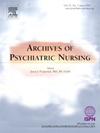开放式还是封闭式护理站更好?对谁更好?范围审查
IF 2.2
4区 医学
Q1 NURSING
引用次数: 0
摘要
住院护士和医院管理人员经常讨论封闭式与开放式护理站的好处。这一范围综述综合了精神科住院病房建筑最佳实践的科学现状,并确定了关于封闭式和开放式护理站的文献差距。从PubMed、CINAHL、EBSCO和Web of Science中提取9篇同行评议文章进行综述。这些文章都是用英语写的,发表于2015年至2024年之间。所有纳入的研究都发生在成人精神科住院病人身上。定性研究和一项混合方法研究,其样本包括住院护士、护理人员、患者及其护理人员。研究结果表明,患者和护理人员更倾向于开放式护理站;然而,只有一些护士和护理人员可能更喜欢开放的护理站。反对开放护理站的护士和护理人员表达了对缺乏无病人空间的焦虑,对工作人员指导的病人暴力的焦虑,以及对违反病人保密的恐惧。据报道,有物理有机玻璃屏障的护理站对患者的吸引力和污名化程度较低。据报道,在开放护理站的单位,治疗联盟更好,因为工作人员更积极,更频繁地与患者互动,患者的需求得到更及时的照顾,患者认为环境更温暖。需要进一步的研究来确定成人住院病房,特别是护理站的最佳建筑设计的实践标准。本文章由计算机程序翻译,如有差异,请以英文原文为准。
Is an open or enclosed nursing station better, and for whom? A scoping review
The benefits of enclosed versus open nursing stations are frequently discussed among inpatient nurses and hospital administrators. This scoping review synthesizes the state of the science on architectural best practices for inpatient psychiatric units and identifies gaps in the literature about enclosed versus open nursing stations. Nine peer reviewed articles from PubMed, CINAHL and EBSCO, and Web of Science were extracted for review. These articles were written in English and published between 2015 and 2024. All included studies occurred on adult inpatient psychiatric units. Qualitative and one mixed method study whose sample included inpatient nurses, nursing staff, patients, and their caregivers were included. Findings suggest a preference for an open nursing station by patients and caregivers; however, only some nurses and nursing staff may prefer open nursing stations. Nurses and nursing staff who are averse to open nursing stations express anxiety regarding a lack of a patient-free space, and anxiety regarding staff-directed violence by patients, and fear of breaching patient confidentiality. Nursing stations with a physical plexiglass barrier were reported to feel less inviting and stigmatizing by patients. The therapeutic alliance was reportedly better in units with open nursing stations because staff interacted more positively and frequently with patients, patient needs were more promptly attended to, and patients perceived the milieu as warmer. Further research is needed to identify a standard of practice for optimal architectural designs of adult inpatient units, especially nursing stations.
求助全文
通过发布文献求助,成功后即可免费获取论文全文。
去求助
来源期刊
CiteScore
3.70
自引率
0.00%
发文量
131
审稿时长
160 days
期刊介绍:
Archives of Psychiatric Nursing disseminates original, peer-reviewed research that is of interest to psychiatric and mental health care nurses. The field is considered in its broadest perspective, including theory, practice and research applications related to all ages, special populations, settings, and interdisciplinary collaborations in both the public and private sectors. Through critical study, expositions, and review of practice, Archives of Psychiatric Nursing is a medium for clinical scholarship to provide theoretical linkages among diverse areas of practice.

 求助内容:
求助内容: 应助结果提醒方式:
应助结果提醒方式:


